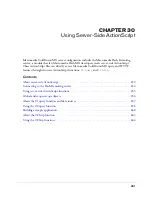
636
Chapter 28: Charting and Graphing Data
Setting curve chart characteristics
Curves use the attributes already discussed. However, you should be aware that curve charts
require a large amount of processing to render. For fastest performance, create them offline, write
them to a file or variable, then reference them in your application pages. For information on
creating offline charts, see
“Writing a chart to a variable” on page 627
.
Linking charts to URLs
ColdFusion provides a data drill-down capability with charts. This means you can click on an area
of a chart, both the data and the legend areas, to request a URL. For example, if you have a pie
chart and want a user to be able to select a pie wedge for more information, you can build that
functionality into your chart.
You use the
url
attribute of the
cfchart
tag to specify the URL to open when a user clicks
anywhere on the chart. For example, define a chart that opens the page moreinfo.cfm when a user
clicks on the chart using the following code:
<cfchart
xAxisTitle="Department"
yAxisTitle="Salary Average"
url="moreinfo.cfm"
>
<cfchartseries
seriesLable="Department Salaries"
...
/>
</cfchart>
You can use the following variables in the
url
attribute to pass additional information to the
target page:
•
$VALUE$
The value of the selected item, or an empty string
•
$ITEMLABEL$
The label of the selected item, or an empty string
•
$SERIESLABEL$
The label of the selected series, or empty string
<cfloop index="i" from="1"
to="#HireSalaries.RecordCount#">
<cfset HireSalaries.AvgByStart[i]
=Round(HireSalaries.AvgByStart[i]
/1000)*1000>
</cfloop>
Round the salaries to the nearest thousand.
<cfchart
chartWidth=400
BackgroundColor="##FFFF00"
show3D="yes" >
<cfchartseries
type="area"
query="HireSalaries"
valueColumn="AvgByStart"
itemColumn="StartDate"
/>
</cfchart>
Create a line chart using the HireSalaries query.
Chart the average salaries against the start date.
Limit the chart width to 400 pixels, show the chart in
3-D, and set the background color to white.
Code
Description
Summary of Contents for ColdFusion MX
Page 1: ...Developing ColdFusion MX Applications...
Page 22: ...22 Contents...
Page 38: ......
Page 52: ...52 Chapter 2 Elements of CFML...
Page 162: ......
Page 218: ...218 Chapter 10 Writing and Calling User Defined Functions...
Page 250: ...250 Chapter 11 Building and Using ColdFusion Components...
Page 264: ...264 Chapter 12 Building Custom CFXAPI Tags...
Page 266: ......
Page 314: ...314 Chapter 14 Handling Errors...
Page 344: ...344 Chapter 15 Using Persistent Data and Locking...
Page 349: ...About user security 349...
Page 357: ...Security scenarios 357...
Page 370: ...370 Chapter 16 Securing Applications...
Page 388: ...388 Chapter 17 Developing Globalized Applications...
Page 408: ...408 Chapter 18 Debugging and Troubleshooting Applications...
Page 410: ......
Page 426: ...426 Chapter 19 Introduction to Databases and SQL...
Page 476: ...476 Chapter 22 Using Query of Queries...
Page 534: ...534 Chapter 24 Building a Search Interface...
Page 556: ...556 Chapter 25 Using Verity Search Expressions...
Page 558: ......
Page 582: ...582 Chapter 26 Retrieving and Formatting Data...
Page 668: ......
Page 734: ...734 Chapter 32 Using Web Services...
Page 760: ...760 Chapter 33 Integrating J2EE and Java Elements in CFML Applications...
Page 786: ...786 Chapter 34 Integrating COM and CORBA Objects in CFML Applications...
Page 788: ......
















































